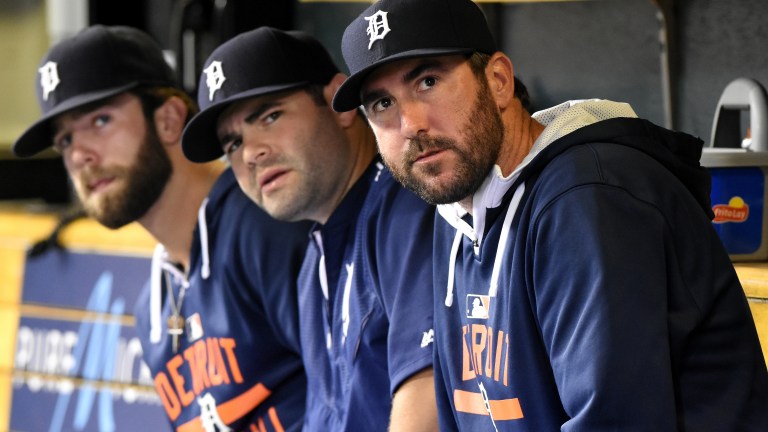MLB Teams That Went from First to Worst
One of the worst things to happen in sports is to go from first to worst. Here are some of the MLB teams that have earned that distinction.

These are the teams that took the elevator from the rooftop to the basement.
The inability for some to sustain success has sometimes gone to a tremendous degree, never more so than in 1915 when the Philadelphia A’s, which sold a majority of their key players for younger and cheaper replacements. The result was an astonishing 56-game difference.
While nobody matches that stark of a contrast, here are others who also made no stops on their way down.
1986-87 California Angels
It can’t be proven that Dave Henderson sent the Halos into a tailspin, but it’s far more than a coincidence. California was one strike away from making the ’86 World Series, until the backup outfielder homered in Game 5 in Anaheim. The Angels lost that day, then lost the next two in Boston, and proceeded to lose 87 in 1987.
To be fair, the AL West was quite balanced and Gene Mauch’s club shared the cellar with the Texas Rangers. But it was clear a window that was closing the year before, had slammed shut. Mike Witt, who was the runner-up for the 1986 AL Cy Young Award, regressed to a 4.01 ERA. In fact, no Angels starter had an ERA below 4.00.
1992-93 Oakland A’s
The mini-AL dynasty built by GM Sandy Alderson and manager Tony LaRussa, which had won the division four times from 1988-92, completely cratered. Free agency, injuries, inconsistency, and trades were all to blame.
Dave Stewart headed to Toronto and Rickey Henderson was soon to follow. Walt Weiss was dealt to the expansion Florida Marlins. Mark McGwire stayed, but foot pain limited him to just 27 games.
The A’s went from 94 wins to 96 losses, the franchise’s worst record since 1982, and they wouldn’t get above .500 again until the end of the decade.
1994-95 Montreal Expos
This one deserves an asterisk. The fate of the Expos is the cruel byproduct of the players’ strike that prematurely ended the ’94 season. Montreal was on top of the NL East with the league’s best record.
A postseason and who knows what happens. As it turned out, a franchise that was strapped for cash went under more financial strain. Thus, several players who made the Expos contenders were sent away: Larry Walker, Ken Hill, John Wetteland, and Marquis Grissom.
The result was immediate. In spite of the brilliance of Pedro Martinez, who would be gone just a few years later, Montreal dropped to 66-78 and 24 games behind first place.
1996-97 San Diego Padres
If you read the last feature on “Worst-to-First” teams, you might remember the ’98 Padres were on that list. So, yes, they pulled off the first-to-worst-to-first trick.
San Diego’s valley was mainly a result of a four-team division (just before the inclusion of the Diamondbacks) and despite losing 86 games, the rest of the West was good enough to collectively outpace the Pads.
Tony Gwynn’s perpetual league-leading average was countered by bad pitching, as no starter had an ERA better than 4.13.
1999-00 Texas Rangers
The turn of the century meant a turn for the worse in Texas. The 1999 lineup had six players hit at least 20 home runs. The 2000 lineup had just two. The 1999 offense masked the liabilities of a generous pitching staff during the division-winning season. The 2000 offense totally exposed it in a 91-loss campaign.
In fact, Rangers pitchers regressed. The total ERA was a putrid 5.52, allowing more than six runs a game. Texas stayed in last for most of the year, but was at .500 and only 7.5 games out in mid-July. It went 27-57 the rest of the way.
2010-11 Minnesota Twins
With the exception of the Philadelphia A’s of more than a century ago, no team endured a larger crater. For the Twins this would be a remarkable 34-win drop-off from the previous year.
Joe Mauer and Justin Morneau combined to play in 151 games while Francisco Liriano, the ace of the 2010 staff, saw his ERA balloon to over 5.00 in 2011 (despite throwing a no-hitter early in the year). If the Twins did accomplish anything, it was in avoiding the dreaded century mark in losses. They finished with 99.
2013-14 Boston Red Sox
The 2013 Sox responded to a last-place finish in 2012 with a World Series. The 2014 Sox responded to the World Championship with a title hangover. Like the Padres of the late ’90s, Boston endured peaks and valleys during this three-year span.

At 71-91, John Farrell’s second season as manager went nothing like his first. Aside from a typical 30-homer, 100-RBI performance from David Ortiz, the rest of the Red Sox offense was relatively absent with the worst OPS+ in the American League. Boston lost 10 straight in May to fall nine under and never recovered.
2014-15 Detroit Tigers
The Tigers of 2014 had a rotation worthy of a World Series: Justin Verlander, Max Scherzer, Rick Porcello, and David Price. Four starters, four Cy Young winners. That year, Detroit was the best in the Central, going 90-72. In the postseason, the bullpen did the Tigers in during the Division Series.
That winter, Scherzer and Porcello went elsewhere and their losses were felt. Detroit dropped only 14 games, but the improved Kansas City Royals distanced on them by 20.5 with the other three clubs sandwiched in between.
